Okay, you’ve been working in the fiber arts for at least a few years now and you are beginning to have a stash- a backlog of materials and tools that you will have a use for in the future. As an artist, this stash of yours is important. It functions as your palette and it stimulates your creative process. There is something very satisfying to be able to go to your stash and to be inspired by what you see. Even better, when you are able to pull all the items you need for your next project from your stash– well, you feel like a rock star! The problem is, of course, storing these treasures and keeping track of them. If you stick them in boxes and hide them in closets you forget about them. If you don’t put them away, you and your family will soon be inundated with your stash.
Here are some ideas on storage.
Darlene Barr: As an art quilter, I’ve accumulated and keep on hand materials that may qualify me a certified fabricholic. I’ve seen studios in magazines that feature clear plastic boxes with neatly folded squares of fabric stacked tidily on shelves. I’ve tried that system and it doesn’t work for me. For one thing, I can’t really see what is down there in the middle of the stack. Then when I remove a piece, I upset the stack and when I put something back, I either put it on top or jam it into the pile and pretty soon have a mess again. At this point, I have a dilemma: do I want to spend my time keeping things tidy, or do I want to create art?
Here’s a system that has worked for me. My teeny-tiny scraps still end up in boxes by color. It is still an archeological dig (but can be exciting). Larger pieces I wrap on file folders and keep in a lateral file.
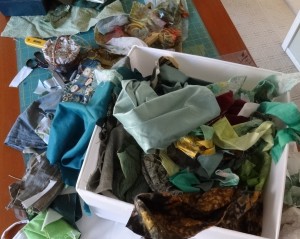
ohh! I can’t find a thing!
Here is how it works.
I iron each piece, folding it to a width that is comfortable for a hanging file folder. Then I staple one edge to the folder.
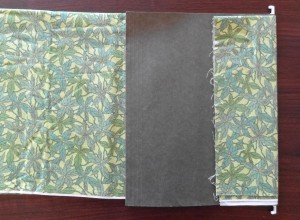
Fabric stapled to the file folder
Then I wrap the fabric around the folder, ironing it to make it more compact. At the end, I pin the loose edge down.
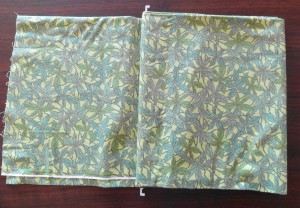
Wrapping the fabric around the file folder
Even fat quarters work this way.
This photo shows how the fabrics appear as I look down into a lateral file. The system works with either letter or legal files in a cabinet, plastic crate, or even (if not too heavily loaded) in a banker’s box. File folders are inexpensive and readily available. One might insert a sheet of acid-free tissue or use plastic files, but in ten years I haven’t seen any ill effects from normal file folders.
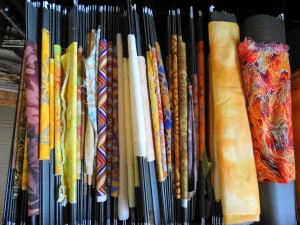
Looking down on the file folder stash
I started out organizing fabrics by value as well as color. One can see I’ve gotten sloppy over the years. But this remains the best way I’ve discovered to keep an array of fabrics organized, visible, and under control.
Georg Palmer: Lately I’ve been doing collages using fabric. The collage ends up as part of a jacket or vest and many become scarves. However, this means I have to keep track of many small pieces of material and it’s best if they are organized by color. They also have to be available where I can see them and grab them. Storage boxes don’t work as I need to see everything, not just the top layer.
My solution – wine boxes and empty yarn cones. The wine boxes are divided into small compartments. I lay them on their side on a shelf and put materials in the small sections by color. When I had no more room for the wine boxes, I filled the remaining spaces with empty cones and filled them by color. The filled shelves are attractive and it it easy to find what I need .
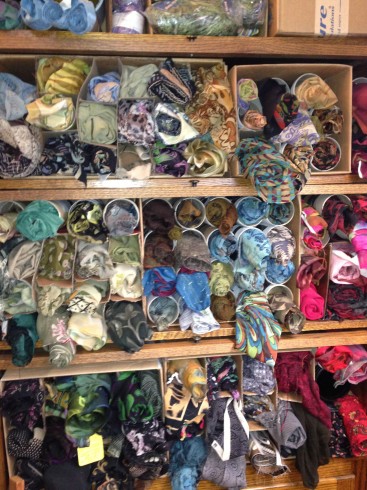
shelves of fabric scraps
Judy Fisher: I have a backlog of woven handwoven fabrics. To store them until I’m ready for use, I roll them. The wide materials go on a pole and are stored-racked- in a closet. The narrower pieces are rolled and stored with others in clear plastic boxes. I try to tag them with yardage and content so they don’t need to be unrolled when looking for a certain amount of fabric. The important thing is that I can see them, almost at a glance, which makes them easy to think about and I can get them out without messing up the other fabrics.
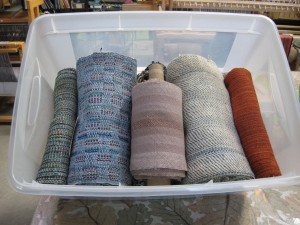 Narrow handwoven fabric rolled and waiting |
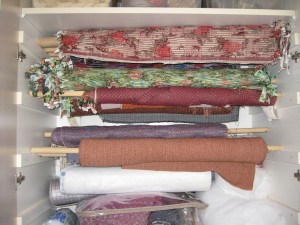 Handwoven yardage rolled and waiting |
I also keep most of my yarns out where I can see them. I’ve been storing them in the open for 30+ years and have had no trouble with bugs and minimal trouble with fading.







